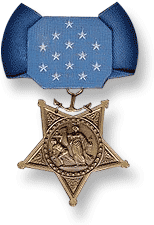Robert M. Hanson
| Robert Murray Hanson | |
|---|---|
  Robert M. Hanson, Medal of Honor recipient World War II flying ace | |
| Nickname | "Butcher Bob"[1] |
| Born |
February 4, 1920 Lucknow, India |
| Died |
February 3, 1944 (aged 23) KIA over Rabaul, New Britain |
| Allegiance | United States of America |
| Service/branch | United States Marine Corps |
| Years of service | 1942 – 1944 |
| Rank | First lieutenant |
| Unit | VMF-214 |
| Battles/wars | World War II |
| Awards |
Medal of Honor Navy Cross Distinguished Flying Cross Air Medal Purple Heart |
Robert Murray Hanson (February 4, 1920-February 3, 1944) was a United States Marine Corps flying ace who shot down 25 Japanese planes from the South Pacific skies. He posthumously received the Medal of Honor. He is the elder brother of Edith Hanson and Earl Dorchester Hanson.
Early years
Robert M. Hanson was the son of Methodist missionaries who served for several decades in India. In Lucknow, India, his playmates were Hindu children. He attended an American-run missionary school, Woodstock School, in Mussoorie in the Western Indian Himalayas, along with his siblings. After attending junior high school in the United States, he returned to India to become light-heavyweight and heavy-weight wrestling champion of the United_Provinces_of_Agra_and_Oudh, at the time a large province in northern India. In his honor, the sports field at his alma mater Woodstock School in the Indian Himalayas is still named Hanson Field.
World War II
In the spring of 1938, on his way back to the United States to attend college, he bicycled his way through Europe and was in Vienna during the Anschluss. He was attending Hamline University, St. Paul, Minnesota, at the time of the attack on Pearl Harbor. He enlisted for naval flight training in May 1942 and earned his wings and a Marine Corps commission as a second lieutenant on February 19, 1943 in Corpus Christi, Texas.
First Lieutenant Hanson arrived in the South Pacific in June 1943 and his daring tactics and total disregard for death soon became well known. A master of individual air combat, he downed 20 enemy planes in six consecutive flying days. He was commended in the citation accompanying the Medal of Honor for his bold attack against six enemy torpedo bombers, November 1, 1943, over Bougainville Island, and for bringing down four Zeros, the premier Japanese fighter, while fighting them alone over New Britain, January 24, 1944.
A member of VMF-214 flying the F4U Corsair, the ace was shot down twice. The first time, a Zero caught him over Bougainville Island. Bringing his plane down on the ocean, he paddled for six hours in a rubber life raft before being rescued by a destroyer. His second and fatal crash occurred one day before his twenty-fourth birthday. He was last seen on February 3, 1944, when his plane crashed into the sea while he was flying an escort mission over Rabaul, New Britain. He was subsequently declared killed in action.
The Medal of Honor was presented to the lieutenant's mother by Maj. Gen. Lewie G. Merritt on August 19, 1944 in Boston, Massachusetts.
Medal of Honor citation
The President of the United States takes pleasure in presenting the MEDAL OF HONOR to
FIRST LIEUTENANT ROBERT M. HANSON
UNITED STATES MARINE CORPS RESERVE
for service as set forth in the following CITATION:
- For conspicuous gallantry and intrepidity at the risk of his life above and beyond the call of duty as a fighter pilot attached to Marine Fighting Squadron TWO FIFTEEN in action against Japanese forces at Bougainville Islands, November 1, 1943, and New Britain Island, January 24, 1944. Undeterred by fierce opposition and fearless in the face of overwhelming odds, First Lieutenant Hanson fought the Japanese boldly and with daring aggressiveness. On November 1, while flying cover for our landing operations at Empress Augusta Bay, he dauntlessly attacked six enemy torpedo bombers, forcing them to jettison their bombs and destroying one Japanese plane during the action. Cut off from his division while deep in enemy territory during a high cover flight over Simpson Harbor on January 24, First Lieutenant Hanson waged a lone and gallant battle against hostile interceptors as they were orbiting to attack our bombers and, striking with devastating fury, brought down four Zeros and probably a fifth. Handling his plane superbly in both pursuit and attack measures, he was a master of individual air combat, accounting for a total of 25 Japanese aircraft in this theater of war. His great personal valor and invincible fighting spirit were in keeping with the highest traditions of the United States Naval Service.[2]
See also
- United States Marine Corps aviation
- List of Medal of Honor recipients
References
- Inline
- General
 This article incorporates public domain material from websites or documents of the United States Marine Corps.
This article incorporates public domain material from websites or documents of the United States Marine Corps.
- Bibliography
- Crowder, Michael J. (2000). United States Marine Corps Aviation Squadron Lineage, Insignia & History - Volume One - The Fighter Squadrons. Paducah, KY: Turner Publishing Company. ISBN 1-56311-926-9.
- Web
- "First Lieutenant Robert M. Hanson, USMCR". Who's Who in Marine Corps History. History Division, United States Marine Corps. Retrieved December 1, 2007.
- "Medal of Honor — 1stLt Robert M. Hanson (Medal of Honor citation)". Marines Awarded the Medal of Honor. History Division, United States Marine Corps. Archived from the original on 2007-02-20.